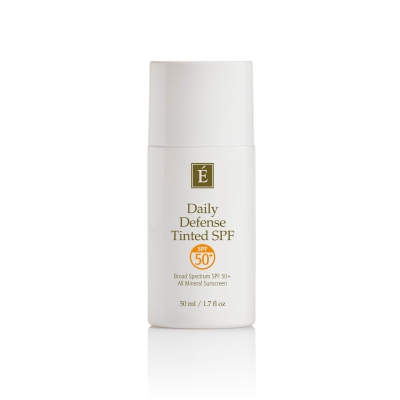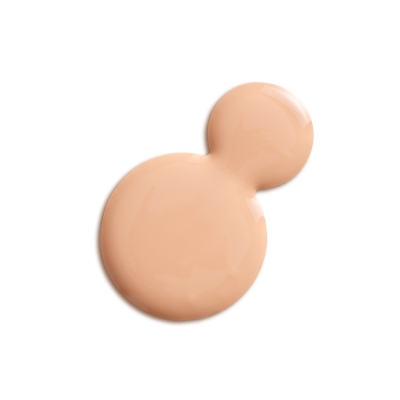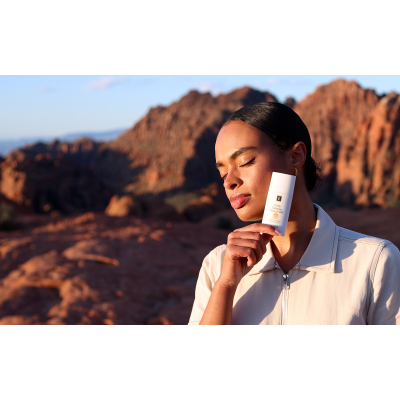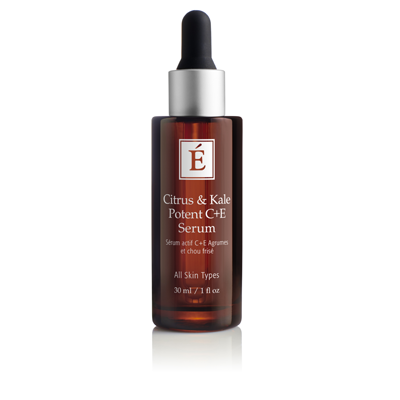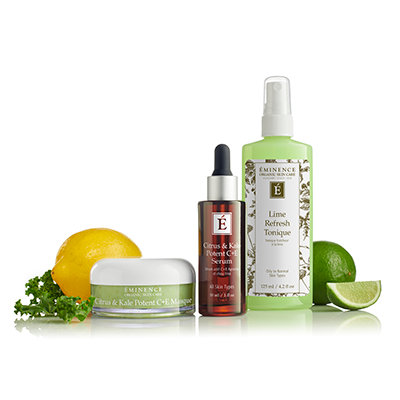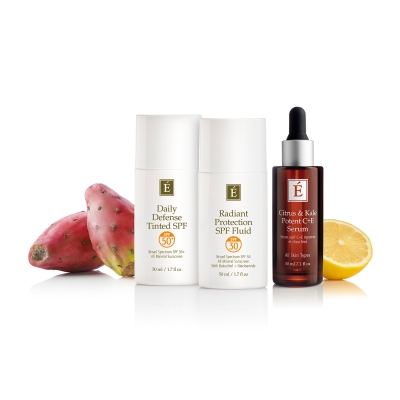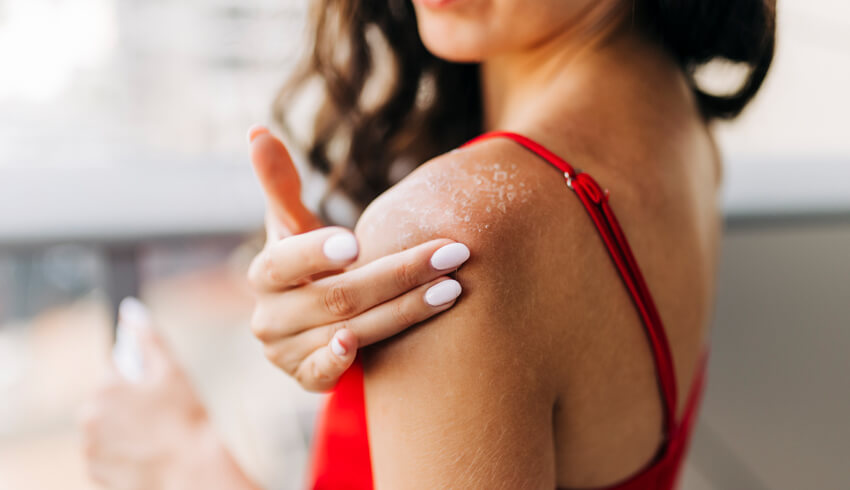
What Does Sun Damaged Skin Look Like?
Years of spending time outdoors in the sun will take a toll on our skin. The hours and days we’ve logged exposed to the elements can be seen in dark spots, wrinkles, sagging skin and discoloration. Unfortunately for sun lovers, sun damage can age our skin prematurely and increase our risk of developing skin cancer. Read on for the most common signs and symptoms of sun damage on the face and body, and to find out how to improve the appearance of your skin.
Signs & Symptoms Of Sun Damage | How To Protect Your Skin From Sun Damage
Sun Damage On The Face: Signs & Symptoms To Look Out For
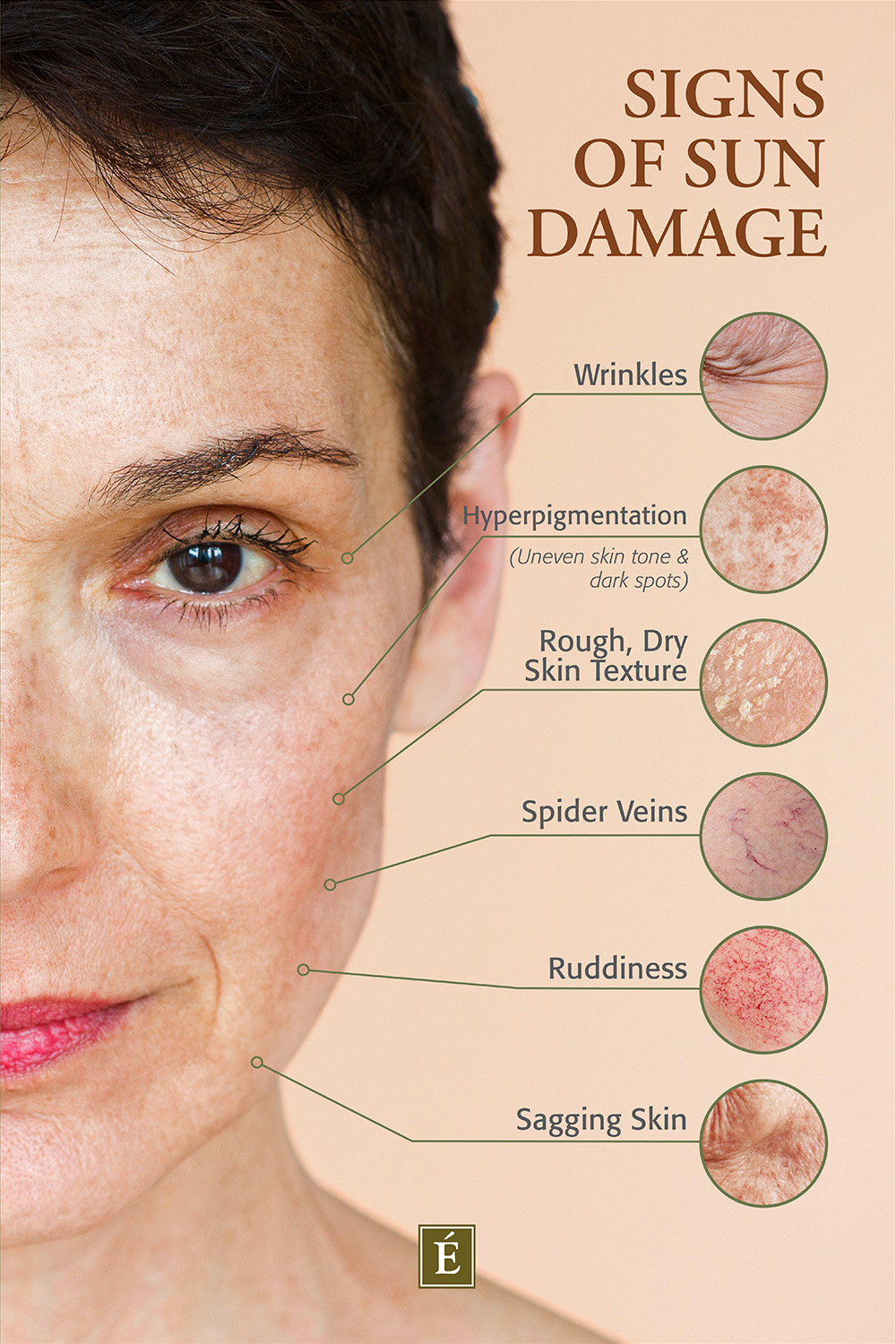
Unlike typical chronological aging, which is determined by your age and genetics, sun damage occurs when UV light from the sun permanently changes the skin’s structure. Symptoms include:
Rough, Dry Skin Texture
After many years of UV exposure, you may develop textural changes in the skin. This can look like scaly patches and crusty skin that is thicker in density and raised from the surface. According to the American Academy of Dermatology Association, you may spot deep lines or dry, scaly patches called actinic keratoses (AKs), which are pre-cancerous skin growths. This type of sun damage can also lead to skin cancer, as AK sometimes turns into a type of skin cancer called squamous cell carcinoma. Keeping an eye on any changes in your skin and consulting a doctor will help you catch any potential skin cancers early.
Wrinkles & Fine Lines
Long-term changes in the skin's collagen, which gives the skin its elasticity, can be a symptom of sun damage. These changes can include fine lines, wrinkles and a thickened skin texture. Unfortunately, lengthy exposure to UV rays prematurely ages your skin and results in the loss of collagen and skin elasticity. In fact, an astonishing 90% of visible aging is caused by exposure to the sun’s UV rays.
Sagging, Loose Skin
Elastin and collagen are two proteins in the skin that deteriorate, not only due to the natural aging process, but also because of external factors over time. These factors include too much sun exposure, as well as lifestyle choices such as poor nutrition, excessive alcohol consumption and smoking. This breakdown of collagen and elastin production causes loose, sagging skin.
Spider Veins
As collagen deteriorates, fragile collagen structure leads to decreased pressure around the blood vessels and reduced elasticity of the skin. This change means spider veins are more likely to appear at the skin’s surface as a network of red, purple, and blue lines reminiscent of a spider’s web.
A Ruddy Complexion
It's possible for a ruddy complexion to be inherited. However, it can also be caused by excessive sun exposure. Ruddy skin is characterized by a reddish appearance and skin that looks uneven, blotchy or has broken capillaries.
Hyperpigmentation
Uneven skin pigmentation (or hyperpigmentation) is a broad term that refers to an uneven skin tone or dark spots appearing. With uneven skin tone, you’ll notice parts of the skin have become discolored or darkened, caused by either sun damage or genetics. Skin pigmentation can be categorized as either a raised lesion (papule or plaque) or a flat lesion (patch or macule).
Another type of hyperpigmentation can be seen in moles. Any abnormal change in your skin is a good reason to consult a doctor to check for signs of skin cancer. A spot that was a light color when you first noticed it in your 30s can change appearance later on in life. Keep an eye on these dark spots, and visit your doctor if you notice changes in color, texture, size or shape.
Dark spots, also known as sun spots, liver spots or lentigines, are yet another type of hyperpigmentation. They look like extra-large freckles or flat brown spots. These form from chronic exposure to UV light and they typically appear on your arms, legs, face, hands, neck and décolletage. This is different from skin pigmentation issues which occur when cells become damaged, reducing melanin production.
If you’ve noticed any of these skin issues, read on to find out how to protect your skin from further sun damage and improve the health of your skin.
How To Protect Your Skin From Sun Damage
If you want to keep your skin looking radiant and healthy long term, below are six steps you can take to protect your skin.
1. Apply SPF Every 2 Hours
SPF is a preventative tool but only if you wear it and remember to reapply it. Reapply an SPF of 30 or above evenly every two hours. You may wish to apply more frequently if you are sweating, toweling off or coming into contact with water.
2. Limit Time Outdoors & Wear Protective Clothing
Restrict your time outdoors when the sun is at its peak (generally from about 10am to 4pm in most parts of the US). The Skin Cancer Foundation says you should cover up with clothing, hats and sunscreen. You should also seek shade, especially when the sun is strongest.
3. Choose A Sunscreen With SPF 30 Or Higher
If you recognize any of these symptoms of sun damaged skin, the first step you can take is putting the brakes on any further damage. One of the most effective preventative formulas is sunscreen. By introducing SPF into your daily skin care routine, you’re warding off the early signs of aging and other sun damage with minimal effort, so use a sunscreen with a broad-spectrum SPF (sun protection factor) value of 30 and above regularly. Our Daily Defense Tinted SPF is a mineral sunscreen with broad spectrum SPF 50+ protection. This non-comedogenic, silicone-free formula ensures your pores stay clear while promoting a healthy glow. Read this guide to learn about the benefits of sunscreen and why you need to wear it every day.
4. Look For "Broad-Spectrum" On The Label
While SPF measures how well the formula protects you from UVB rays, it won’t tell you anything about protection from UVA light. That’s why the second factor to look for in a sunscreen is a label stating "broad-spectrum." This label means you’re getting protection from both UVA and UVB rays. UVA rays are what you can blame for the signs of wrinkles and fine lines. In comparison, UVB rays are responsible for causing sunburn and skin cancer.
5. Choose an SPF With Moisturizing Ingredients
If you have dry skin due to sun exposure, particular ingredients will help bring the moisture back. Our Radiant Protection SPF Fluid, for example, has a hydrating, nourishing feel while also helping protect the skin from the harsh effects of the sun.
6. Regularly Check Your Body
Whenever you exit the bath or shower, check your body from head to toe to become familiar with your skin and recognize whether any new spots appear. Keep a close eye on existing spots too, noting whether their appearance alters in any way. A reminder that a change in size, shape, color or border is a red (or pink or brown) flag that should be checked out by your doctor.
7. Use Products With Vitamins & Antioxidants
If you apply SPF and also use products with vitamins and antioxidants in them, you are truly defending your skin from the sun. Consider vitamins C and E, along with SPF, as your skin's ultimate shield against environmental elements! While SPF blocks UVA and UVB rays, the nutrients found in our serums, such as the Citrus & Kale Potent C+E Serum, protect your skin against dryness associated with environmental stressors. This serum, rich in antioxidants from citrus, leafy greens and avocado, works perfectly with our SPF products to boost your skin's defense.
Are you dealing with signs of sun damage? View our range of sun care products to shield yourself from harmful UV rays or visit your nearest Eminence Organics Spa Partner for help identifying and reversing skin damage.
